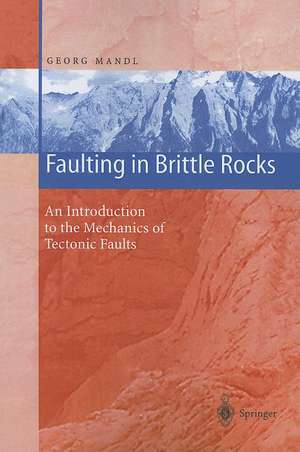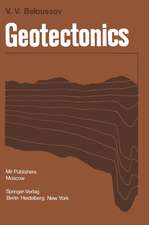Faulting in Brittle Rocks: An Introduction to the Mechanics of Tectonic Faults
Autor Georg Mandlen Limba Engleză Paperback – 30 noi 2010
| Toate formatele și edițiile | Preț | Express |
|---|---|---|
| Paperback (1) | 801.40 lei 38-44 zile | |
| Springer Berlin, Heidelberg – 30 noi 2010 | 801.40 lei 38-44 zile | |
| Hardback (1) | 957.94 lei 6-8 săpt. | |
| Springer Berlin, Heidelberg – 25 noi 1999 | 957.94 lei 6-8 săpt. |
Preț: 801.40 lei
Preț vechi: 1054.47 lei
-24% Nou
Puncte Express: 1202
Preț estimativ în valută:
153.35€ • 167.09$ • 129.22£
153.35€ • 167.09$ • 129.22£
Carte tipărită la comandă
Livrare economică 19-25 aprilie
Preluare comenzi: 021 569.72.76
Specificații
ISBN-13: 9783642085703
ISBN-10: 3642085709
Pagini: 448
Ilustrații: X, 434 p. 290 illus., 4 illus. in color.
Dimensiuni: 155 x 235 x 24 mm
Greutate: 0.7 kg
Ediția:Softcover reprint of the original 1st ed. 2000
Editura: Springer Berlin, Heidelberg
Colecția Springer
Locul publicării:Berlin, Heidelberg, Germany
ISBN-10: 3642085709
Pagini: 448
Ilustrații: X, 434 p. 290 illus., 4 illus. in color.
Dimensiuni: 155 x 235 x 24 mm
Greutate: 0.7 kg
Ediția:Softcover reprint of the original 1st ed. 2000
Editura: Springer Berlin, Heidelberg
Colecția Springer
Locul publicării:Berlin, Heidelberg, Germany
Public țintă
ResearchDescriere
This book provides an introduction into the mechanics of faulting in the brittle crust of the Earth. It developed from my annual two-semester course on tectono mechanics for graduate students of engineering geology and of rock engineering at the Technical University of Graz (Austria). In this course, it is not my task to present a broad exposition and geometrical description of geological structures, but rather to focus on the mechanical processes that produce the structures. Although this was also the aim of my former book "Mechanics of Tectonic Faulting - Models and Basic Concepts" (1988, Elsevier), henceforth referred to as MTF, the present book is different in organisation and content, in order to meet the requirements of the courses and to include more recent developments. Instead of following the traditional subdivision into extensional, compressional and strike-slip faulting, the presentation focuses on mechanical aspects of tectonic faulting that are common to various, or even all types of tectonic faults in the brittle regime. In this way, geometrically disparate or dissimilar fault structures may be revealed as closely related by the underlying mechanical process, and complex structures may be better understood. It may be useful to indicate how the chapters in the book are organised. The first three chapters are an introduction to rock mechanics, tailored to applications in geology. It also presents the extremely useful graphical method of Mohr's stress circle, which is freely used throughout the book to keep the mathematics to an absolute minimum.
Cuprins
1 Stress and Strain in Rocks.- 2 The Stress Circle.- 3 The Brittle Regime.- 4 The Coulomb — Mohr Theory of Faulting.- 5 Poro — Thermo — Elasticity of Rocks.- 6 Fault Structures.- 7 Slip, Reactivation and Termination of Faults.- 8 Parallel Faults.- 9. Modelling of Faulting — Scaling Problems.- Autors.
Textul de pe ultima copertă
The book presents an introduction to the mechanical genesis of tectonic faults in the brittle crust of the Earth. In the first chapters mechanical concepts of rock (such as brittleness, stresses in a discontinuum, effective stress, buoyancy, poro-thermo-elasticiy, fracture modes and the corresponding failure and slip conditions) are discussed. The book focuses on the critical re-assessment of Coulomb-Mohr's theory of sliding deformation in rocks, and explores the wide range of fault structures that can be analysed by this theory. Strong emphasis is laid on the effects of pore pressure changes. Phenomena, such as the growth, spacing, and reactivation of faults, the distribution of fault slip, and the formation of certain shear joints, which lie outside the scope of Coulomb-Mohr's simple theory, are tackled by different theoretical, numerical and experimental methods. The book concludes with a discourse on similarity and self-similarity of fault structures and a critical examination of the feasibility of scaled model experiments. Mathematical formalism is restricted to a minimum and is replaced, wherever possible, by the extremely useful graphic method of Mohr's stress circle which is introduced in a separate chapter. The book includes illustrative geological and geotechnical examples.
Caracteristici
Mathematical formalism is restricted to a minimum
Practical approach with several application examples
Practical approach with several application examples















